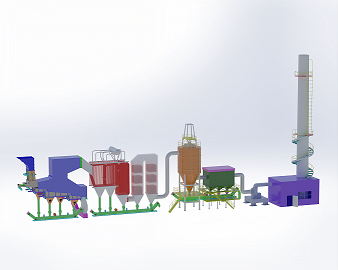The Steps of Correct Shutdown
Preparation after receiving the shutdown order: Immediately start all preparations before shutdown.
Boiler inspection and record keeping: Conduct a comprehensive inspection of the boiler and record any equipment defects found to facilitate maintenance after shutdown.
Boiler Cleaning: Carry out comprehensive boiler cleaning.
Reduce load and adjust equipment: Keep in touch with the running boiler, gradually reduce the load, and make corresponding adjustments to the equipment. When the load drops to 40% of the rated load, switch the automatic feedwater regulator to manual mode and closely monitor the drum water level.
Decoupling operation: When the steam temperature is lower than 360℃ or the steam flow rate is 0, the decoupling operation with the steam main pipe is performed.
Garbage burnout and emptying: Ensure that the garbage in the chute is burned out and manually empty the garbage on the chute deck if necessary.
Shutdown parameter control: control the furnace flue gas temperature drop rate, steam temperature drop rate and steam pressure drop rate within the set range.
The shutdown principle of the grate type waste incinerator: is to follow a series of steps, including closing the hopper sealing door, putting the auxiliary burner into operation, reducing the steam and air volume, shutting down the grate, etc., until the garbage on the grate is completely burned.
Ash treatment and equipment shutdown: After the burnt ash is sent to the slag discharger, the grate operation is stopped. The ash conveying system of each flue and equipment is stopped according to regulations.
Shut down the slag remover and hydraulic station: The slag remover stops running after the ash and slag in it are completely drained. After all hydraulic cylinders stop, the hydraulic station stops running.
Boiler disconnection and water supply control: When disconnecting and stopping steam supply, close the electric and manual main steam valves, open the main steam pipe drain valve, and keep the drum water level slightly higher than the normal water level.
Superheater cooling and pressure reduction: After closing the main steam valve, open the superheater outlet header drain valve to cool the superheater. Pay attention to controlling the cooling speed of the boiler to avoid rapid cooling.
Water level and pressure monitoring after shutdown: Pay attention to maintaining the drum water level after shutdown, and continue to monitor the boiler pressure and motor status.
Natural ventilation and water replacement: Do not open the manhole door and smoke and air duct damper within 8 hours after the furnace is shut down. Natural ventilation can be carried out after 8 hours, and then the water replacement operation can be carried out. Pay attention to the method and steps of water replacement.
Draining water and reducing drum pressure: When the boiler pressure drops to a certain range, the boiler water can be drained. Open the drum air valve to ensure smooth draining.
These steps ensure the safety and effectiveness of the shutdown process, while protecting the boiler and related equipment and preparing for the next startup. Throughout the shutdown process, operating procedures and safety standards should be strictly followed.





